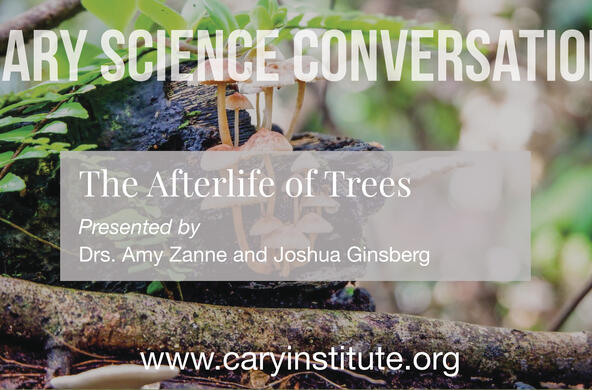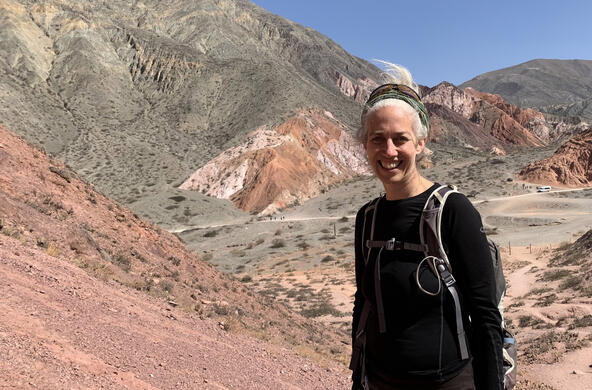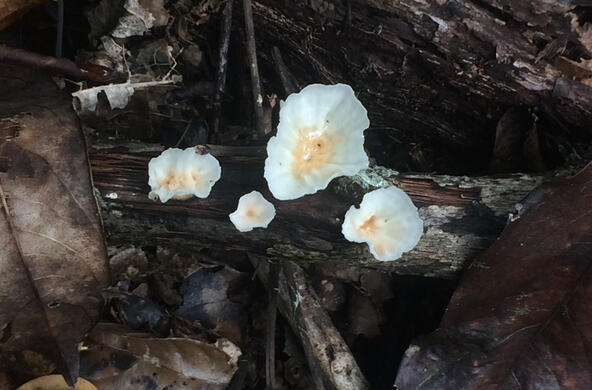This event was live streamed on October 24, 2025. You may watch a recording of the talk online.
Nature lovers can explore the eerie yet essential world of decomposition in an upcoming lecture at the Cary Institute of Ecosystem Studies, just in time for Halloween.
Dr. Amy Zanne will speak in conversation with Cary President Dr. Joshua Ginsberg about the hidden world of dead trees. Topics will include the fungi that drive decomposition — like dead man’s fingers and glowing Jack-O’-Lantern mushrooms — and the termites that quietly shape the forest.
The lecture will take place in person and online Friday, Oct. 24, from 7 to 8 p.m. The event is free and open to the public.
With a Ph.D. from the University of Florida, and having traveled and studied on every continent, Zanne has accumulated an extensive network of colleagues and a vast wealth of knowledge about the interactions among plants, microbes and insects that influence carbon cycling and climate change. And yet, she manages to distill very complex information and make it understandable — and exciting — to the masses. Her enthusiasm for ecology and biology is contagious.
Known for her collaborative approach, Zanne often brings together scientists who study different scales of decomposition, from enzymes to ecosystems.
“Only a small fraction of termites cause problems for people,” she said excitedly, mythbusting common misconceptions, “but most play a vital role in recycling carbon. I love connecting people who study these overlooked organisms to see the bigger picture.”
After studying at field sites in Australia, Brazil, Chile and Antarctica, her current home is the Cary Institute, where she studies how species’ traits affect carbon release and storage.
Today, Zanne focuses on how carbon moves through nature in areas like forests, grasslands and deserts. She examines what happens to carbon in plants and dead wood as they break down, and how factors like heat, moisture, fungi and termites affect that process.
Her love for science began in childhood when Zanne grew up on a farm in New Hampshire and developed a love of the outdoors. The bucolic upbringing allowed her to run through the hills, pick blueberries in the summertime and enjoy the surrounding landscape.
“I had a real comfort in being outside,” she said. “As kids, we had a big garden and were constantly digging in the rocky, granite soils of New Hampshire, always pulling out rocks and examining them.” She also enjoyed learning how the environment cycled on the farm.
Later, inspired in high school and college by a number of teachers and professors, Zanne knew she wanted to make science her profession. It was when she enrolled in biology and genetics classes that a spark was ignited.
Zanne reflected, “What makes that magic click in your brain? I don’t know — but whatever it was, I loved my biology classes in high school. That really set me on the path to studying biology in college.” She attended Dartmouth College where she took a variety of courses, including ecology.
Asked if she had a favorite place among her travels, Zanne joked that the question was like choosing a favorite child. “When you travel, you leave little pieces of your heart all over the world,” she said. “You’re never just one person anymore — you have many homes wherever you go. I’ve been so lucky to meet incredible people and see such beautiful places.”
Zanne’s upcoming talk at the Cary Institute will explore what happens after trees die — the “afterlife” of wood and the creatures that inhabit it. Drawing on her research in places as far as Antarctica, Brazil and Chile, she studies how carbon moves through ecosystems, and how it happens on a smaller scale with individual fallen logs, or in entire landscapes.
Her work connects the smallest processes to the global carbon cycle. “I’m interested in how the tiny things happening inside a log affect what’s happening in the atmosphere,” she explained. “It’s about connecting the micro to the global.”
Fittingly timed for Halloween, her lecture promises a “spooky” dive into death, decay and the hidden world inside and around dead trees.






